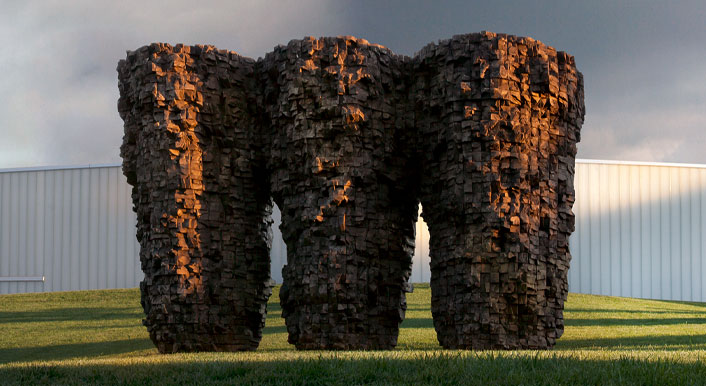FOR IMMEDIATE RELEASE
Generous Grant from Bank of America Allows for Three Bowls Restoration in View of Public
Kansas City, MO. Aug. 14, 2024–A popular nine-foot-tall sculpture at The Nelson-Atkins Museum of Art in Kansas City will undergo needed conservation work in full view of the public Sept. 3-6 thanks to a generous grant from Bank of America. Three Bowls, Ursula von Rydingsvard’s monumental cedar and graphite sculpture on the east side of the Donald J. Hall Sculpture Park, consists of three interlocking, hollow bowl forms. Cement footings support the bowls and stainless-steel rods attach them to the footings, with drainage existing beneath each.
“We are deeply grateful to Bank of America for funding this important project and for their continued stewardship of art conservation around the world,” said Julián Zugazagoitia, Director & CEO of the Nelson-Atkins.
An assessment of Three Bowls uncovered several condition issues that require immediate attention.
“Three Bowls has developed a weathered and sun-bleached appearance, along with a few deep cracks, due to prolonged exposure to the elements,” said Mary Schafer, Head, Conservation and Senior Conservator. “Conservation staff, in collaboration with the artist’s studio, will treat the sculpture and install a new landscape barrier to ensure its long-term protection.”
The museum purchased Three Bowls from Galerie Lelong in New York City in 1999 through the generosity of The Hall Family Foundation, the George H. and Elizabeth O. Davis Fund, G. Kenneth Baum, and Judy and Alan Kosloff. Three Bowls was installed on the grounds of the Kansas City Sculpture Park, which is now the Donald J. Hall Sculpture Park, in 2005.
Bank of America awarded conservation grants to 24 nonprofit cultural institutions around the world this year. The bank’s Art Conservation Project, which launched in 2010, has granted museums large and small across the world with more than $20 million to conserve paintings, tapestries, sculptures, photographs, and other works of art, says Brian Siegel, global arts, culture, and heritage executive. Each year, the project fields 80 to 100 proposals from nonprofit cultural institutions and chooses between 20 and 25 with the assistance of a panel of conservation professionals. The merit of each proposal is considered, but the evaluators also want to ensure funding reaches a variety of artworks and institutions across the globe.
“We are delighted to support The Nelson-Atkins Museum of Art with a grant from the Bank of America Art Conservation Project,” said Matt Linski, president, Bank of America Kansas City. “The funding will enable needed conservation of the sculpture Three Bowls, created by Ursula von Rydingsvard, and demonstrates our commitment to maintaining and elevating diverse works of art for future generations to treasure.”
For the onsite treatment days, the artist’s assistant will fill cracks in the cedar timber with hand-carved wood shims and reapply graphite powder to restore the surface’s original appearance. Once the treatment is complete, protective coatings will be applied to help prolong the sculpture’s renewed condition. Ursula von Rydingsvard (b. 1942) is an important figure in the world of contemporary sculpture. Born in Germany during World War II to parents of Polish descent, she spent the first eight years of her life in camps for displaced people. These early experiences with deprivation, austere living conditions, and instability inform both the form and content of her work. Von Rydingsvard transforms ordinary, domestic, and agricultural implements, the family tools of survival, into extraordinary, monumental objects.
Three Bowls references Minimalism in terms of its massive, iconic form and seriality. Its agitated, expressive surfaces recall those of Alberto Giacometti’s sculptures. In the tradition of Eva Hesse, von Rydingsvard’s art is deeply involved with process and institution. She sculpts intuitively and without drawings or models to guide her process. The roughly hewn, steeply vertical surfaces of Three Bowls are reminiscent of weathered, rocky cliffs. This impression is reinforced by saturating the wood with black graphite which silvers as it ages.
When it was acquired in 1999, Three Bowls represented a significant addition to the Kansas City Sculpture Park (now the Donald J. Hall Sculpture Park) on the grounds of The Nelson-Atkins Museum of Art. The 22-acre park features 45 sculptures and welcomes more than 125,000 visitors annually as a valued urban greenspace. Three Bowls is the only wooden sculpture in the sculpture park.
Organized by The Nelson-Atkins Museum of Art. Generous support provided by the Hall Family Foundation.
